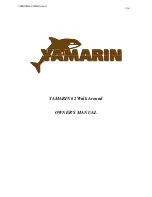
WEIGHT
Crew Weight:
Always
race at maximum weight
allowed by the class:
400 kg
. It is better to be
heavy in light winds than
to be light in high winds.
Since the J/24 starts to
heel at eight knots, you
will almost always be
hiking.
Boat Weight:
Remove
everything from the
boat. Carry only what
is required by the rules,
and each of those things
at minimum weight, like
the anchor and outboard
engine.
Crew Gear:
You spend
hours removing things,
cleaning the boat, buy-
ing lightest shackles and
reducing the weight of
every piece of spare
equipment, which is all
the more reason to limit
what your crew brings
aboard. You can’t imag-
ine how much five bags
full of clothes can weigh.
Headstay Length:
The
headstay length should
be the maximum al-
lowed by the class rules.
The measurement is
taken from the center of
the headstay pin at the
hounds to the intersec-
tion of the stem/sheer
line. The total length
should be
8670mm
.
Because the heastay hole
in the bow of your boat is
approximately
65mm
up
from the stem/sheer line
intersection, the actual
length of the heastay
from the centers of each
hole should be
8605mm
Mast Length:
The mast
length should be mini-
mum allowed by the class
rules. Contact a class
measurer as this is a com-
plicated process.
Your shrouds may be too
long to get adequate
rig tension if you have
to shorten the mast. If
this is the case, you may
be able to shorten the
shrouds by cutting the
turnbuckles.
Spreader Angle/De-
flections:
First, cut the
spreaders to the mini-
mum length allowed by
the class rules, which is
760mm
. Pull the spread-
ers back as far as they
will go using a string tied
around the shrouds at
the spreader tips. Then
measure from the middle
of the string to the aft
face of the mast. The
spreaders are at the right
angle when the measure-
ment is
165mm
. Tape the
spreader ends to protect
the spinnaker and genoa.
After Stepping the Mast
Butt Position:
The front
face of the mast should
be
2845mm
from the
bottom bolt of the bow
stem fitting (looking
forward while in side the
boat) to the forward face
of the mast at the “I”
beam. Block the mast
(at the partners) solid at
2910mm
from the stem/
sheer line intersection for
the maximum “J” length.
Centering the Rig:
Adjust
the upper shrouds hand
tight and center the top
of the mast. To find if the
mast is centered, hang a
bucket of water approxi-
mately one foot above
the deck from the genoa
halyard. The bucket of
water puts a constant
load on the halyard.
Next put a tape mark on
the halyard about two
feet above the bucket’s
handle. Then swing
the halyard out to the
starboard upper shroud
and put a tape mark
at the same height as
the one on the halyard.
Now put a similar tape
mark on the port upper
shroud. The last step is
to measure from the tape
marks to the base of the
chainplate on each side.
If one measurement is
shorter than the other,
tighten the shroud on
the long side until the
two measurements are
the same. UK Sailmak-
ers has a video of this
under the Education tab
of the home page: www.
uksailmakers.com. Finally,
measure side to side to
find out if the mast is in
the middle of the boat at
the partners.
Tensioning for Base
Settings:
Using a Loos
Tension Gauge Mode
B, tighten the upper
shrouds to
20
and the
lowers to
15
on each
side.
Adjust the backstay bridle
turnbuckles so that the
roller is about 10” below
the connector plate. With
this measurement you
will need to have
2 1/4”
of pre-bend. Tighten or
loosen your backstay
TUNING THE RIG























